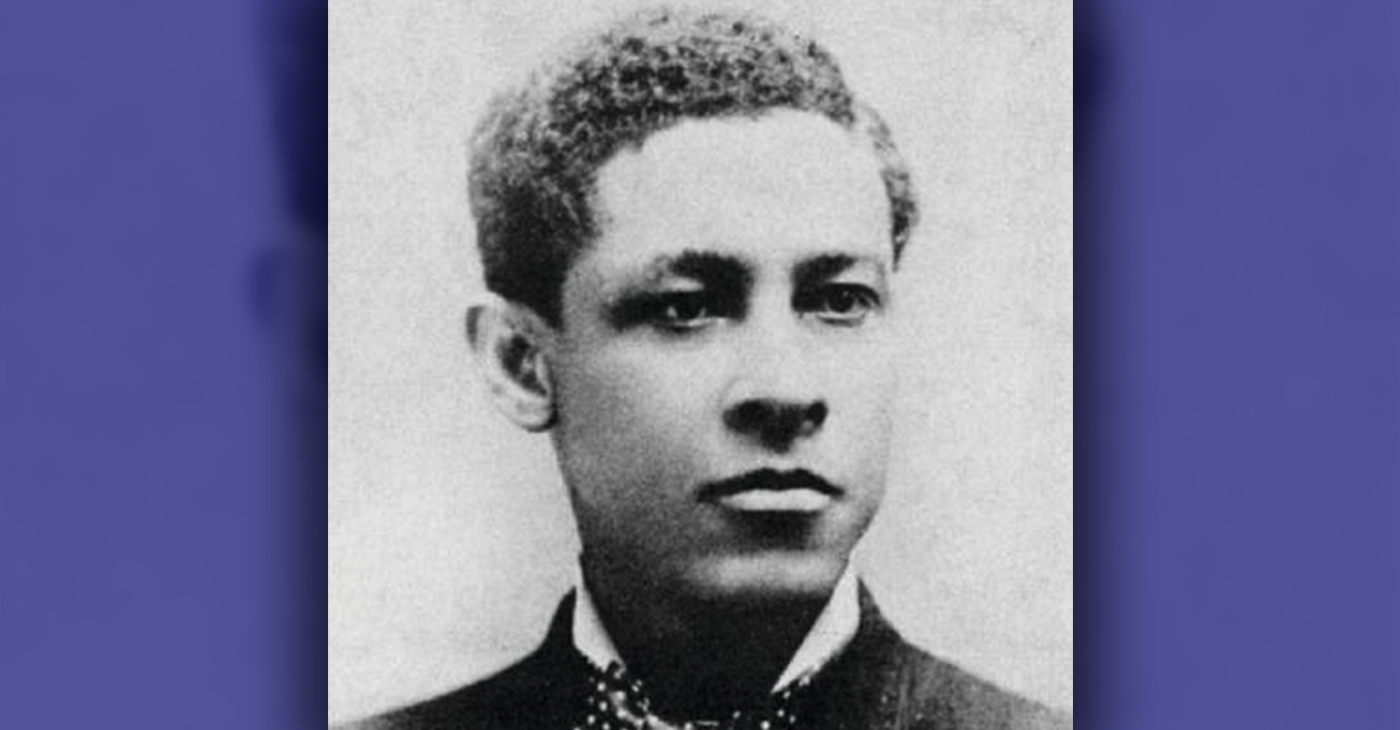Black History
Jan Ernst Matzeliger’s Invention Revolutionized Shoe Manufacturing
A cordwainer is a shoemaker who makes new shoes from new leather. Lasting is the part of the process that sets the final shape of a shoe and holds it in place so the outsole can be permanently attached. Designing a machine to perform the lasting was thought to have been impossible. But Jan Ernst Matzeliger (1852–1889), was determined to automate this task. And with persistence, he was successful. He revolutionized the industry of shoemaking with his lasting machine. It cut the cost of manufacturing shoes in half, thereby making shoes more affordable.

By Tamara Shiloh
The craft of shoemaking was at one time difficult and manual work. But with the advent of the Industrial Revolution, cobblers and cordwainers cut, sewed, and tacked shoes with machines.
The inner and outer soles were attached with machines and other devices were used to sew uppers to lowers. The final part of the process though, remained manual: the lasting.
A cordwainer is a shoemaker who makes new shoes from new leather. Lasting is the part of the process that sets the final shape of a shoe and holds it in place so the outsole can be permanently attached.
Designing a machine to perform the lasting was thought to have been impossible. But Jan Ernst Matzeliger (1852–1889), was determined to automate this task. And with persistence, he was successful. He revolutionized the industry of shoemaking with his lasting machine. It cut the cost of manufacturing shoes in half, thereby making shoes more affordable.
Little is known about Matzeliger’s early life. He was born on the northern coast of South America in Paramaribo, Dutch Guiana (now the Republic of Suriname). By age 10, he was apprenticed in the machine shops. He had an interest in machinery and mechanics, and at the same time, desired to see the world.
At 19, Matzeliger went to sea on an East Indian merchant ship. When reaching America, he decided to stay in Philadelphia. There he worked odd jobs, one being a shoemaker’s apprentice.
Being a Black man limited his professional options; he struggled to make a decent living. By 1876, he would relocate to Boston. After a brief stay, he settled in Lynn, Mass., where shoemaking was an established industry.
Matzeliger was soon hired at Harney Brothers’ shoe factory, where he operated a McKay sole-sewing machine and ran a heel-burnisher and a buttonhole machine. He wanted to learn more about the craft, so he studied the hand lasters as they worked.
A hand laster pulls and secures lining uppers over lasts (a mechanical form shaped like a human foot) to form leather shoes of designated size, then trims away the excess material with a knife.
At night, Matzeliger began to duplicate the movements of the lasters. He secretly made drawings as he experimented with various materials. Six months later, his employer offered $50 for the unfinished machine. Matzeliger rejected it.
Four years later, after reconstructing the machine using iron, Matzeliger was offered $1,500. Again, he rejected it and continued to improve his machine. After 10 years, people began to laugh at Matzeliger and his efforts, but he refused to be discouraged. Eventually, when the time became right, he sought investors and was able to finance a patent.
In 1883, Matzeliger received a patent for his lasting machine. The first public operation of the machine took place in 1885, when the machine broke a record by lasting 75 pairs of shoes. He later received several other patents for shoe-manufacturing machinery.
Unfortunately, in pursuing his work, Matzeliger sacrificed his health working long hours and not eating for long periods of time. He died of tuberculosis three weeks before his 37th birthday, never reaping the profit of his invention.
Encourage your tweens to read more in Barbara Mitchell’s “Shoes for Everyone: A Story about Jan Matzeliger.”
Black History
Matthew Henson: Explorer Extraordinaire
Matthew Henson, a trailblazing explorer who overcame countless obstacles to leave an incredible mark on history. Born on August 8, 1866, in Charles County, Maryland, his journey is a testament to the power of determination and the spirit of adventure.

By Tamara Shiloh
Matthew Henson, a trailblazing explorer who overcame countless obstacles to leave an incredible mark on history. Born on August 8, 1866, in Charles County, Maryland, his journey is a testament to the power of determination and the spirit of adventure.
Henson’s life began amidst the backdrop of post-Civil War America, where opportunities for African Americans were scarce. From a young age, he possessed an insatiable curiosity about the world beyond his small town. At the age of 12, he embarked on a journey that would change the course of his life forever when he joined a merchant ship as a cabin boy.
His most famous expedition was his journey to the Arctic with renowned explorer Robert E. Peary. In 1887, Henson joined Peary’s crew as a seaman and quickly proved himself to be invaluable with his skills as a navigator and craftsman. Over the course of several expeditions, Matthew endured extreme cold, treacherous terrain, and grueling conditions as he and Peary sought to reach the elusive North Pole.
In 1908–09, Peary set out on his eighth attempt to reach the North Pole. It was a big expedition, with Peary planning to leave supplies along the way. When he and Henson boarded their ship, the Roosevelt, leaving Greenland on August 18, 1909, they were joined by a large group. This included 22 Inuit men, 17 Inuit women, 10 children, 246 dogs, 70 tons of whale meat, blubber from 50 walruses, hunting gear, and tons of coal.
In February, Henson and Peary left their anchored ship at Ellesmere Island’s Cape Sheridan, along with the Inuit men and 130 dogs. They worked together to set up a trail and supplies along the way to the Pole.
Peary picked Henson and four Inuit people to join him in the final push to the Pole. However, before they reached their destination, Peary couldn’t walk anymore and had to ride in a dog sled. He sent Henson ahead to scout the way. In a later interview with a newspaper, Henson recalled being in the lead and realizing they had gone too far. The group turned back, and Henson noticed his footprints helped guide them to their destination. At that location, Henson planted the American flag.
Henson’s legacy extends far beyond his expeditions to the Arctic. He shattered racial barriers in the world of exploration and inspired countless individuals, regardless of race, to dream big and pursue their passions. In 1937, he was finally recognized for his achievements when he was inducted into The Explorers Club, an organization dedicated to promoting scientific exploration and field research.
Matthew Henson died in the Bronx, New York, on March 9, 1955, at the age of 88.
Art
Marin County: A Snapshot of California’s Black History Is on Display
The Marin County Office of Education, located at 1111 Las Gallinas Ave in San Rafael, will host the extraordinary exhibit, “The Legacy of Marin City: A California Black History Story (1942-1960),” from Feb. 1 to May 31, 2024. The interactive, historical, and immersive exhibit featuring memorabilia from Black shipyard workers who migrated from the South to the West Coast to work at the Marinship shipyard will provide an enriching experience for students and school staff. Community organizations will also be invited to tour the exhibit.

By Post Staff
The Marin County Office of Education, located at 1111 Las Gallinas Ave in San Rafael, will host the extraordinary exhibit, “The Legacy of Marin City: A California Black History Story (1942-1960),” from Feb. 1 to May 31, 2024.
The interactive, historical, and immersive exhibit featuring memorabilia from Black shipyard workers who migrated from the South to the West Coast to work at the Marinship shipyard will provide an enriching experience for students and school staff. Community organizations will also be invited to tour the exhibit.
All will have the opportunity to visit and be guided by its curator Felecia Gaston.
The exhibit will include photographs, articles and artifacts about the Black experience in Marin City from 1942 to 1960 from the Felecia Gaston Collection, the Anne T. Kent California Room Collection, The Ruth Marion and Pirkle Jones Collection, The Bancroft Library, and the Daniel Ruark Collection.
It also features contemporary original artwork by Chuck D of the Rock and Roll Hall of Fame group Public Enemy, clay sculptures by San Francisco-based artist Kaytea Petro, and art pieces made by Marin City youth in collaboration with Lynn Sondag, Associate Professor of Art at Dominican University of California.
The exhibit explores how Marin City residents endured housing inequities over the years and captures the history of plans to remove Black residents from the area after World War II. Throughout, it embodies the spirit of survival and endurance that emboldened the people who made Marin City home.
Felecia Gaston is the author of the commemorative book, ‘A Brand New Start…This is Home: The Story of World War II Marinship and the Legacy of Marin City.’ Thanks to the generous contribution of benefactors, a set of Felecia’s book will be placed in every public elementary, middle, and high school library in Marin.
In addition, educators and librarians at each school will have the opportunity to engage with Felecia in a review of best practices for utilizing the valuable primary sources within the book.
“Our goal is to provide students with the opportunity to learn from these significant and historical contributions to Marin County, California, and the United States,” said John Carroll, Marin County Superintendent of Schools.
“By engaging with Felecia’s book and then visiting the exhibit, students will be able to further connect their knowledge and gain a deeper understanding of this significant historical period,” Carroll continued.
Felecia Gaston adds, “The Marin County Office of Education’s decision to bring the Marin City Historical Traveling Exhibit and publication, ‘A Brand New Start…This is Home’ to young students is intentional and plays a substantial role in the educational world. It is imperative that our community knows the contributions of Marin City Black residents to Marin County. Our youth are best placed to lead this transformation.”
The Marin County Office of Education will host an Open House Reception of the exhibit’s debut on Feb. 1 from 4 p.m. – 6 p.m.. All school staff, educators, librarians, and community members are encouraged to attend to preview the exhibit and connect with Felecia Gaston. To contact Gaston, email MarinCityLegacy@marinschools.org
Activism
Oakland Post: Week of April 10 – 16, 2024
The printed Weekly Edition of the Oakland Post: Week of April 10 – 16, 2024

To enlarge your view of this issue, use the slider, magnifying glass icon or full page icon in the lower right corner of the browser window. ![]()
-

 Activism4 weeks ago
Activism4 weeks agoOakland Post: Week of March 20 – 26, 2024
-

 #NNPA BlackPress3 weeks ago
#NNPA BlackPress3 weeks agoCOMMENTARY: D.C. Crime Bill Fails to Address Root Causes of Violence and Incarceration
-

 #NNPA BlackPress3 weeks ago
#NNPA BlackPress3 weeks agoMayor, City Council President React to May 31 Closing of Birmingham-Southern College
-

 #NNPA BlackPress3 weeks ago
#NNPA BlackPress3 weeks agoCOMMENTARY: Lady Day and The Lights!
-

 #NNPA BlackPress3 weeks ago
#NNPA BlackPress3 weeks agoFrom Raids to Revelations: The Dark Turn in Sean ‘Diddy’ Combs’ Saga
-

 #NNPA BlackPress3 weeks ago
#NNPA BlackPress3 weeks agoBaltimore Key Bridge Catastrophe: A City’s Heartbreak and a Nation’s Alarm
-

 #NNPA BlackPress3 weeks ago
#NNPA BlackPress3 weeks agoBaltimore’s Key Bridge Struck by Ship, Collapses into Water
-

 Activism3 weeks ago
Activism3 weeks agoOakland Post: Week of March 27 – April 2, 2024















































